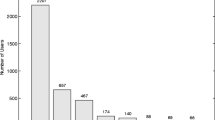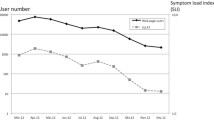Abstract
Pollen allergies affect a large part of the European population and are considered likely to increase. User feedback indicates that there are difficulties in providing proper information and valid forecasts using traditional methods of aerobiology due to a variety of factors. Allergen content, pollen loads, and pollen allergy symptoms vary per region and year. The first steps in challenging such issues have already been undertaken. A personalized pollen-related symptom forecast is thought to be a possible answer. However, attempts made thus far have not led to an improvement in daily forecasting procedures. This study describes a model that was launched in 2013 in Austria to provide the first available personal pollen information. This system includes innovative forecast models using bi-hourly pollen data, traditional pollen forecasts based on historical data, meteorological data, and recent symptom data from the patient’s hayfever diary. Furthermore, it calculates the personal symptom load in real time, in particular, the entries of the previous 5 days, to classify users. The personal pollen information was made available in Austria on the Austrian pollen information website and via a mobile pollen application, described herein for the first time. It is supposed that the inclusion of personal symptoms will lead to major improvements in pollen information concerning hay fever sufferers.


Similar content being viewed by others
References
Asher MI, Montefort S, Bjorksten B, Lai CK, Strachan DP, Weiland SK, Williams H, ISAAC Phase Three Study Group (2006) Worldwide time trends in the prevalence of symptoms of asthma, allergic rhinoconjunctivitis, and eczema in childhood: ISAAC phases one and three repeat multicountry cross-sectional surveys. Lancet 368:733–743
Bastl K, Kmenta M, Jäger S, Bergmann KC, Berger U (submitted) Development of a symptom load index–enabling temporal and regional pollen season comparisons and creating a new gateway for Personal Pollen Information. Aerobiologia
Berger U (2007) Wie lassen sich die Akzeptanz und Zugriffszahlen der Besucher des Services www.pollenwarndienst.at durch Veränderung des Informationsangebotes nachhaltig steigern? Master thesis, Vienna University of Economics and Business, pp 104
Berger U, Jäger S, Smith M, Bergmann KC (2013a) Personalized forecasting of pollen induced symptoms for hay-fever sufferers. AAAAI Annual Meeting 2013 San Antonio, USA, Abstract 281
Berger U, Karatzas K, Jaeger S, Voukantsis D, Sofiev M, Brandt O, Zuberbier T, Bergmann KC (2013b) Personalized pollen-related symptom-forecast information services for allergic rhinitis patients in Europe. Allergy 68:963–965. doi:10.1111/all.12181
Bousquet J, Anto J, Auffray C, Akdis M, Cambon-Thomsen A, Keil T et al (2011) MeDALL (Mechanisms of the Development of ALLergy): an integrated approach from phenotypes to systems medicine. Allergy 66:596–604
Buters JTM, Thibaudon M, Smith M, Kennedy R, Rantio-Lehtimäki A, Albertini R, Reese G, Weber B, Galan C, Brandao R, Antunes CM, Jäger S, Berger U, Celenk S, Grewling Q, Jackowiak B, Sauliene I, Weichenmeier I, Pusch G, Sarioglu H, Ueffing M, Behrendt H, Prank M, Sofiev M, Cecchi L, The HIALINE working group (2012) Release of Bet v 1 from birch pollen from 5 European countries. Results from the HIALINE study. Atmos Environ 55:496–505
Celik G, Mungan D, Pinar M, Misirligil Z (2005) Poplar pollen-related allergy in Ankara, Turkey: how important for patients living in a city with high pollen load? Allergy Asthma Proc 26:113–119
D’Amato G, Cecchi L, Bonini S, Nunes C, Annesi-Maesano I, Behrendt H, Liccardi G, Popov T, van Cauwenberge P (2007) Allergenic pollen and pollen allergy in Europe. Allergy 62:976–990
Demoly P, Bousquet J (2006) The relation between asthma and allergic rhinitis. Lancet 368:711–713
De Weger LA, Beerthuizen T, Hiemstra PS, Sont JK (2013) Development and validation of a 5-day-ahead hay fever forecast for patients with grass-pollen-induced allergic rhinitis. Int J Biometeorol. http://www.ncbi.nlm.nih.gov/pubmed/23780494. Accessed 20 June 2013
Galan C, Antunes C, Brandao R, Torres C, Garcia-Mozo H, Caeiro E, Ferro R, Prank M, Sofiev M, Albertini R, Berger U, Cecchi L, Celenk S, Grewling L, Jackowiak B, Jäger S, Kennedy R, Rantio-Lehtimäki A, Reese G, Sauliene I, Smith M, Thibaudon M, Weber B, Weichenmeier I, Pusch G, Buters JTM on behalf of the HIALINE working group (2013) Airborne olive pollen counts are not representative of exposure to the major olive allergen Ole e 1. Allergy 68:809–812
Gonzalo-Garijo MA, Tormo-Molina R, Silva Palacios I, Pérez-Calderon R, Fermànez-Rodrìguez S (2009) Use of a short messaging service system to provide information about airborne pollen concentrations and forecasts. J Invest Allerg Clin 19:414–442
Hugg T, Rantio-Lehtimäki A (2007) Indoor and outdoor pollen concentrations in private and public spaces during the Betula pollen season. Aerobiologia 23:119–129
Hugg T, Valtonen A, Rantio-Lehtimäki A (2007) Pollen concentrations inside private cars during the Poaceae and Artemisia spp. pollen season—a case study. Grana 46:110–117
Karatzas K (2009) Informing the public about atmospheric quality: air pollution and pollen. Allergo Journal 18:212–217
Karatzas KD, Riga M, Smith M (2013) Presentation and dissemination of pollen information. In: Sofiev M, Bergmann KC (eds) Allergenic pollen: a review of the production, release, distribution and health impacts. Springer, Dordrecht, pp 217–247
Lau-Schadendorf S, Wahn U (1994) Prevention of exposure in respiratory allergies. Ther Umsch 51:61–66
Levetin E, Van de Water PK (2003) Pollen count forecasting. Immunol Allergy Clin 23:423–442
Maucher J (2006) Erster österreichischer allergiebericht: einschätzung und realität unterschiedlich. Österreichische Ärztezeitung 11:56–57
Mitakakis TZ, Tovey ER, Xuan W, Marks GB (2000) Personal exposure to allergenic pollen and mould spores in inland New South Wales, Australia. Clin Exp Allergy 30:1733–1739
Prank M, Chapman DS, Bullock JM, Belmonte Soler J, Berger U, Dahl A, Jäger S, Kovtunenko I, Magyar D, Niemelä S, Rantio-Lehtimäki A, Rodinkova V, Sauliene I, Severova E, Sikoparija B, Sofiev M (2013) An operational model for forecasting ragweed pollen release and dispersion in Europe. Agric Forest Meteorol 182–183:43–53
Reiss M (1997) Allergic rhinitis—is allergen elimination a useful form of therapy? Wien Med Wochenschr 147:328–332
Schmid-Grendelmeier P (2012) Pollen allergy and immunotherapy. Ther Umsch 69:239–248
Sehlinger T, Boehm K, Goergen F, Bergmann KC (2013) Measuring individual pollen exposure. AAAAI Annual Meeting 2013, San Antonio, USA, Poster 284
Siljamo P, Sofiev M, Filatova E, Grewling L, Jäger S, Khoreva E, Linkosalo T, Jimenez SO, Ranta H, Rantio-Lehtimäki A, Svetlov A, Veriankaite L, Yakovleva E, Kukkonen J (2012) A numerical model of birch pollen emission and dispersion in the atmosphere. Model evaluation and sensitivity analysis. Int J Biometeorol. http://www.ncbi.nlm.nih.gov/pubmed/22434484. Accessed 22 March 2012. doi: 10.1007/s00484-012-0539-5
Sofiev M, Siljamo P, Ranta H, Linkosalo T, Jaeger S, Rasmussen A, Rantio-Lehtimaki A, Severova E, Kukkonen J (2012) A numerical model of birch pollen emission and dispersion in the atmosphere. Description of the emission module. Int J Biometeorol. http://www.ncbi.nlm.nih.gov/pubmed/22410824. Accessed 13 March 2012. doi: 10.1007/s00484-012-0532-z
Tan RA, Corren J (2011) The relationship of rhinitis and asthma, sinusitis, food allergy, and eczema. Immunol Allergy Clin 31:481–491
Acknowledgments
We are indebted to those at the EAN (European Aeroallergen Network) for their friendly cooperation and the supply of pollen data. We also kindly thank two anonymous reviewers for their feedback.
Author information
Authors and Affiliations
Corresponding author
Rights and permissions
About this article
Cite this article
Kmenta, M., Bastl, K., Jäger, S. et al. Development of personal pollen information—the next generation of pollen information and a step forward for hay fever sufferers. Int J Biometeorol 58, 1721–1726 (2014). https://doi.org/10.1007/s00484-013-0776-2
Received:
Revised:
Accepted:
Published:
Issue Date:
DOI: https://doi.org/10.1007/s00484-013-0776-2




